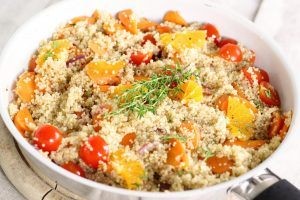Quinoa and its nutritional profile are often misunderstood. At HOW.EDU.VN, we are dedicated to providing clear, expert-backed information to empower your dietary choices. This comprehensive guide will explore the protein content of quinoa, its nutritional benefits, and how it can be effectively incorporated into a balanced diet, offering you expert insights and practical solutions. Discover expert advice, nutritional benefits, and practical tips to enhance your well-being.
1. Understanding Quinoa
Quinoa, often mistaken for a grain, is actually a seed. Originating from the Andean region of South America, it has been a staple food for thousands of years. Known for its impressive nutritional profile, quinoa stands out due to its complete protein content.
1.1. What is Quinoa?
Quinoa (Chenopodium quinoa) is a pseudocereal, meaning it is used similarly to grains but is not a grass. It belongs to the same family as spinach, chard, and beets. The edible seeds come in various colors, including white, red, and black, each with slightly different flavors and textures. Quinoa is naturally gluten-free, making it a popular choice for those with gluten sensitivities or celiac disease.
1.2. History and Cultivation
Quinoa has been cultivated for over 5,000 years in the Andean region of South America, specifically in countries like Bolivia, Peru, Ecuador, and Chile. It was a staple food of the Inca civilization, who referred to it as the “mother grain.” Today, quinoa is grown globally, including in North America, Europe, and Asia, due to its adaptability and nutritional value.
1.3. Nutritional Profile of Quinoa
Quinoa is celebrated for its balanced nutritional composition. It is a good source of carbohydrates, fiber, vitamins, and minerals. However, its most notable feature is its protein content, which is complete and higher than that of most grains.
 Bowl of cooked quinoa with tomatoes and fresh herbs
Bowl of cooked quinoa with tomatoes and fresh herbs
2. Protein Content in Quinoa
Understanding the protein content in quinoa is crucial for individuals looking to optimize their diets. It is a key consideration for vegetarians, vegans, athletes, and anyone seeking to increase their protein intake.
2.1. How Much Protein Does Quinoa Contain?
A one-cup (185 grams) serving of cooked quinoa typically contains about 8 grams of protein. This amount can vary slightly depending on the variety of quinoa and the cooking method.
2.2. Quinoa as a Complete Protein
One of the unique aspects of quinoa is that it is a complete protein. This means it contains all nine essential amino acids that the human body cannot produce on its own. These amino acids are:
- Histidine
- Isoleucine
- Leucine
- Lysine
- Methionine
- Phenylalanine
- Threonine
- Tryptophan
- Valine
Having all these amino acids in one source makes quinoa an excellent protein option, especially for those who do not consume animal products.
2.3. Comparison with Other Grains
Compared to other common grains, quinoa generally contains more protein. Here’s a comparison of the protein content per 100 grams of cooked grains:
| Grain | Protein (grams) |
|---|---|
| Quinoa | 4.4 |
| Rice | 2.7 |
| Wheat | 3.4 |
| Corn | 3.2 |
| Oats | 2.5 |
As the table illustrates, quinoa offers a higher protein content than many other staple grains, making it a valuable addition to a balanced diet.
3. Health Benefits of Quinoa
Beyond its protein content, quinoa offers a range of health benefits due to its rich nutritional profile. These benefits make quinoa a valuable addition to a balanced diet.
3.1. Rich in Essential Nutrients
Quinoa is packed with essential nutrients, including:
- Manganese: Essential for bone health and metabolism.
- Phosphorus: Important for bone health and energy production.
- Magnesium: Supports muscle and nerve function and helps regulate blood sugar levels.
- Folate: Crucial for cell growth and development.
- Thiamin (Vitamin B1): Essential for energy metabolism.
- Iron: Necessary for oxygen transport and energy production.
- Zinc: Supports immune function and wound healing.
3.2. High in Fiber
Quinoa is a good source of dietary fiber, which aids in digestion, helps regulate blood sugar levels, and promotes feelings of fullness. A one-cup serving of cooked quinoa contains about 2.5 grams of fiber.
3.3. Gluten-Free
Being naturally gluten-free, quinoa is an excellent alternative for individuals with celiac disease or gluten sensitivity. It allows them to enjoy grain-like dishes without the adverse effects of gluten.
3.4. May Help Manage Blood Sugar Levels
Quinoa has a relatively low glycemic index (GI) of around 53, meaning it does not cause rapid spikes in blood sugar levels. This makes it a suitable choice for individuals with diabetes or those looking to manage their blood sugar.
3.5. Antioxidant Properties
Quinoa contains various antioxidants, including quercetin and kaempferol, which help protect the body against damage from free radicals. These antioxidants can reduce the risk of chronic diseases.
4. Incorporating Quinoa into Your Diet
Adding quinoa to your diet is easy and versatile. It can be used in a variety of dishes, from breakfast to dinner, offering a nutritious and delicious option.
4.1. Cooking Quinoa
Cooking quinoa is similar to cooking rice. Here’s a simple method:
- Rinse: Rinse the quinoa under cold water using a fine-mesh strainer to remove any remaining saponins, which can give it a bitter taste.
- Combine: In a pot, combine one part quinoa with two parts water or broth.
- Boil: Bring the mixture to a boil, then reduce the heat to low, cover, and simmer for 15 minutes, or until the liquid is absorbed and the quinoa is tender.
- Fluff: Remove from heat and fluff with a fork before serving.
4.2. Quinoa Recipes and Meal Ideas
- Breakfast: Cook quinoa with milk or water and top with fresh fruit, nuts, and a drizzle of honey or maple syrup.
- Lunch: Add cooked quinoa to salads or use it as a base for grain bowls with roasted vegetables, beans, and a flavorful dressing.
- Dinner: Substitute quinoa for rice in stir-fries, casseroles, or as a side dish with grilled meats or vegetables.
- Snacks: Make quinoa salad with chopped vegetables and herbs for a healthy and filling snack.
4.3. Tips for Enhancing Quinoa’s Flavor
- Toast: Toast quinoa in a dry pan before cooking to enhance its nutty flavor.
- Use Broth: Cook quinoa in vegetable or chicken broth instead of water for added flavor.
- Add Herbs and Spices: Experiment with different herbs and spices, such as bay leaves, thyme, garlic powder, or onion powder, while cooking quinoa.
5. Quinoa for Specific Dietary Needs
Quinoa is a versatile food that can be tailored to meet various dietary needs, making it a valuable addition to a wide range of eating plans.
5.1. Vegetarian and Vegan Diets
For vegetarians and vegans, quinoa is an excellent source of complete protein. It can be used in place of meat in many dishes, providing essential amino acids and other nutrients.
5.2. Gluten-Free Diets
As a naturally gluten-free grain, quinoa is a safe and nutritious option for individuals with celiac disease or gluten sensitivity. It can be used to make gluten-free bread, pasta, and other baked goods.
5.3. Weight Management
Quinoa can be a helpful addition to a weight management plan. Its high fiber and protein content can promote feelings of fullness, reducing overall calorie intake.
5.4. Athletes and Active Individuals
Athletes and active individuals can benefit from quinoa’s protein and carbohydrate content, which provide energy and support muscle recovery. It’s also a good source of iron, which is important for oxygen transport during exercise.
6. Potential Downsides of Quinoa
While quinoa is generally safe and nutritious, there are a few potential downsides to be aware of.
6.1. Saponins
Quinoa contains natural saponins, which are bitter-tasting compounds that coat the exterior of the seeds. While most commercially available quinoa is pre-rinsed to remove saponins, it’s still a good idea to rinse it before cooking to ensure any remaining saponins are removed.
6.2. Oxalates
Quinoa contains oxalates, which can bind to calcium and interfere with its absorption. Individuals with kidney problems may need to limit their intake of quinoa and other high-oxalate foods.
6.3. Allergies
Although rare, some individuals may be allergic to quinoa. Symptoms of a quinoa allergy can include skin rashes, itching, hives, and digestive issues.
7. Expert Opinions on Quinoa
Experts in nutrition and dietetics widely recognize the health benefits of quinoa. Their insights can provide additional context and validation for incorporating quinoa into a healthy eating plan.
7.1. Dietitians and Nutritionists
Registered dietitians and nutritionists often recommend quinoa as part of a balanced diet. They highlight its complete protein content, high fiber, and gluten-free nature as key benefits.
7.2. Doctors and Healthcare Professionals
Doctors and healthcare professionals may recommend quinoa to patients with specific dietary needs, such as those with diabetes, celiac disease, or high cholesterol.
7.3. Research Studies
Numerous research studies have investigated the health benefits of quinoa. These studies often focus on its impact on blood sugar levels, cholesterol, and inflammation.
8. Optimizing Quinoa for Maximum Protein Intake
To maximize the protein intake from quinoa, consider these strategies:
8.1. Combining with Other Protein Sources
Pair quinoa with other protein-rich foods, such as beans, lentils, nuts, or seeds, to create a more complete amino acid profile.
8.2. Using Quinoa Flour
Quinoa flour can be used in baking to increase the protein content of breads, muffins, and other baked goods.
8.3. Adding Quinoa to Smoothies
Cooked quinoa can be added to smoothies for a boost of protein and fiber.
9. Sustainable and Ethical Considerations
When choosing quinoa, consider the environmental and ethical implications of its production.
9.1. Environmental Impact
Quinoa cultivation can have environmental impacts, such as soil erosion and water depletion. Choose quinoa that is grown using sustainable farming practices to minimize these impacts.
9.2. Fair Trade
Support fair trade quinoa to ensure that farmers receive fair wages and work in safe conditions.
10. Frequently Asked Questions (FAQs) about Quinoa
10.1. Is quinoa a grain or a seed?
Quinoa is technically a seed, but it is often used and referred to as a grain due to its similar nutritional profile and culinary uses.
10.2. Is quinoa gluten-free?
Yes, quinoa is naturally gluten-free, making it a safe option for individuals with celiac disease or gluten sensitivity.
10.3. How much protein is in one cup of cooked quinoa?
One cup (185 grams) of cooked quinoa contains approximately 8 grams of protein.
10.4. What are the health benefits of quinoa?
Quinoa is rich in essential nutrients, high in fiber, gluten-free, may help manage blood sugar levels, and has antioxidant properties.
10.5. How do I cook quinoa?
Rinse quinoa, combine one part quinoa with two parts water or broth, bring to a boil, reduce heat, cover, and simmer for 15 minutes.
10.6. Can quinoa help with weight loss?
Yes, quinoa’s high fiber and protein content can promote feelings of fullness, which may aid in weight loss.
10.7. Are there any potential downsides to eating quinoa?
Quinoa contains saponins, which can taste bitter if not rinsed properly. It also contains oxalates, which may be a concern for individuals with kidney problems.
10.8. Is quinoa a complete protein?
Yes, quinoa is a complete protein, containing all nine essential amino acids.
10.9. Can I eat quinoa every day?
Yes, quinoa can be part of a balanced diet and can be eaten every day.
10.10. Where can I buy quinoa?
Quinoa is available at most grocery stores, health food stores, and online retailers.
11. Conclusion
Quinoa is a highly nutritious food that offers numerous health benefits, including a significant amount of complete protein. Its versatility and ease of preparation make it an excellent addition to any diet. By understanding its nutritional profile and incorporating it into your meals, you can enjoy the many advantages this ancient grain has to offer.
Seeking expert guidance on incorporating quinoa or other dietary changes into your life? At HOW.EDU.VN, we connect you with leading PhDs and specialists worldwide who can provide personalized advice tailored to your specific needs. Contact us today to unlock the full potential of your health and wellness journey. Our experts are equipped to address your unique challenges and provide actionable solutions. Don’t navigate your health alone – let our team of experts guide you.
Contact Information:
- Address: 456 Expertise Plaza, Consult City, CA 90210, United States
- WhatsApp: +1 (310) 555-1212
- Website: how.edu.vn

